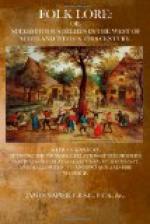“3rd. It was alleged that the said Janet M’Birnie was the cause of the dispute between Newton and his wife, and that she and others were the death of William Geddese. And also that they fand against Marian Laidlaw, another suspected, these particulars: that the said Marian and Jean Blacklaw differed in words for the said Marian’s hay; and after that the said Jean her kye died.”
They were remitted for trial. In these same Records there is in 1697 the following entry:—“Upon the recommendation of the Synod, the Presbytery appoynts a Fast to be keeped upon the 28th instant, in regard to the great prevalence of witchcraft which abounds at several places at this time within the bounds of the Synod.”
At this time the laws against witchcraft had become practically a dead letter, but it was not till 1735 that they were repealed. Still, the abolition of the legal penalty did not kill the popular belief in the power and reality of witchcraft; and even now, at this present day, we find proof every now and again in newspaper reports that this belief still lingers among certain classes. Within these fifty years, in a village a little to the west of Glasgow, lived an old woman, who was not poor, but had a very irritable temper, and was unsocial in her habits. A little boy having called her names and otherwise annoyed her, she scolded him, and, in the heat of her rage, prophesied that before a twelvemonth elapsed the devil would get his own. A few months after this the boy sickened and died, and the villagers had no hesitation in ascribing the cause of death to this old woman. Again, a farmer in the neighbourhood had bought a horse, and in the evening a servant was leading it to the water to drink, when this same old woman, who was sitting near at hand, remarked upon the beauty of the horse, and asked for a few hairs from the tail, which the servant with some roughness refused. When the stable was entered next morning the horse was found dead. On the above circumstance of the old woman’s request being related to the farmer, he regretted the servant’s refusal of the hairs, and said that, if the same woman had asked him, he would have given every hair in the tail rather than offend her, showing thereby his undoubted belief in the woman’s power. Fortunately for her, she lived in a storeyed building—in local vernacular, a land—or in all probability her house would have been set on fire in order to burn her. At the same time, while she was hated and dreaded, everybody for their own safety paid her the most marked respect. Had she lived a century earlier, such evidence would have brought her to the stake. In 1666, before the Lanark Presbytery, a woman was tried for bewitching cattle:—
“The said William Smith said that she was the death of twa meires, and Elizabeth Johnstone, his wife, reported that she saw her sitting on their black meire’s tether, and that she ran over the dyke in the likeness of a hare.”




